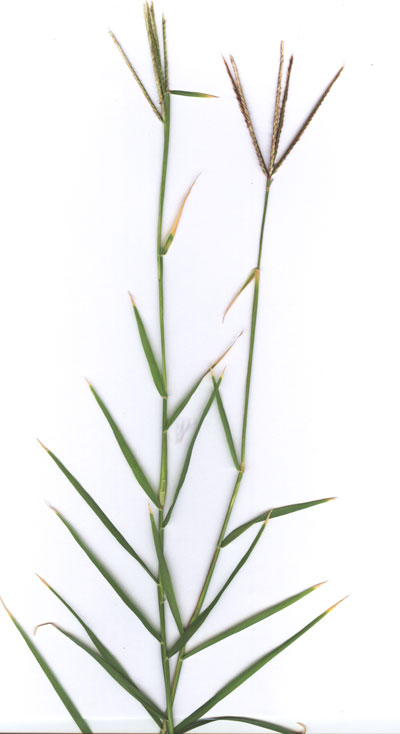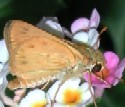Bermuda Grass
Cynodon dactylon

Scan made from specimen found in Phoenix, Maricopa Co., Arizona. 11 Oct, 2008.
PERENNIAL: Perennial grass of pastures and lawns mostly low growing, but
unmown plants can reach ½ meter
tall. Usually spreading by means of
stolons. Plants can grow up and through supporing vegetation.
RANGE: Frequent throughout the Sonoran Desert in Arizona and Mexico at
roadsides, near agriculture and along washes and riparian zones. Used for lawns
- tolerant of high heat in the Sonoran Desert urban environment. This exotic
grass native to Africa is generally dependent on disturbed soils - the soil in
desert washes gets disturbed ecologically every time there is a flood.
FLOWERS: The flowering spikes typically have several to seven branchlets
close together on the central branch. Tinged burgandy at anthesis. Pollen is
dispersed by wind and is a major allergen for some people. Flowers late spring to fall; winter dormant.
LEAVES: Leaf blades are short and narrowly triangular.
FRUIT: Small grains barely a mm long.
UNARMED.
 This non-native grass has been adopted by the
Phyleus Skipper (Hylephila phyleus) as the larval host plant.
Apparently bermuda grass has biochemical and ecological similarities to this
butterfly's original native host. Bermuda grass, which can be a difficult and invasive weed, has been a part of the Sonoran
Desert ecosystem for over 100 years and is slowly being adopted by the native
animals as a food source.
This non-native grass has been adopted by the
Phyleus Skipper (Hylephila phyleus) as the larval host plant.
Apparently bermuda grass has biochemical and ecological similarities to this
butterfly's original native host. Bermuda grass, which can be a difficult and invasive weed, has been a part of the Sonoran
Desert ecosystem for over 100 years and is slowly being adopted by the native
animals as a food source.
Sometimes the flowering spikes will be infected with a fungus that turns the seed heads jet black with spores. The fungus is a type of smut similar to corn smut fungus.